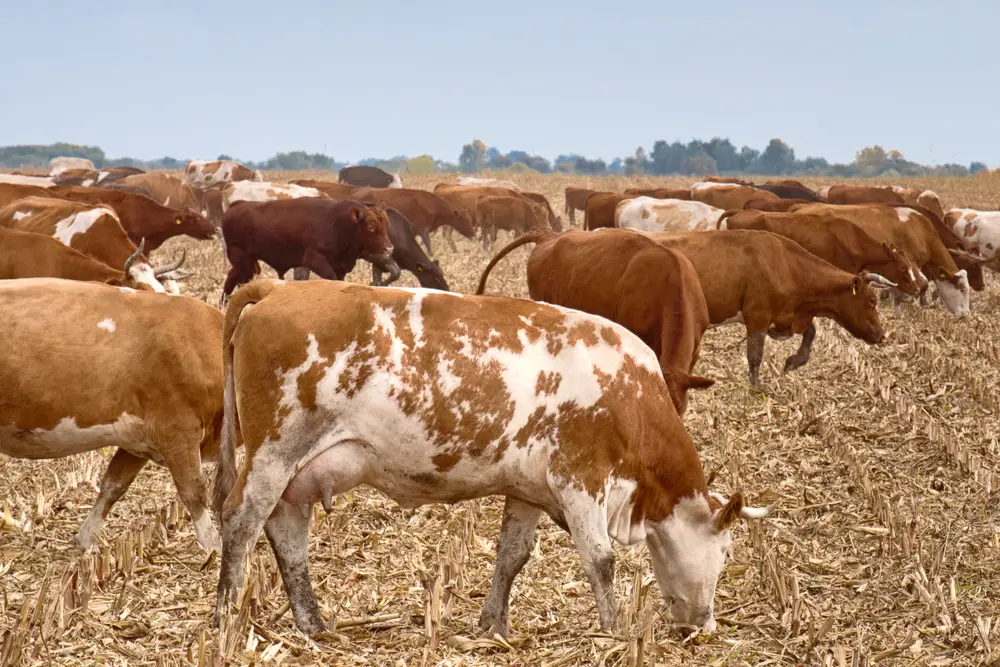Growing oats for cattle feed is wise. Oat is a low-cost high-quality livestock feed rich in fiber, vitamins, proteins, and minerals. Oat is a dual-purpose crop that can be grown for forage or grain.
Oat grain Total Digestible Nutrients (TDN) depend on oat test weight and varies from 66-72%. Here are the nutrient levels in oat grain:
- Crude protein: 11-14%
- Fiber content: 11%
- Calcium: 0.1% of dry matter
- Phosphorus: 0.33%
Table of Contents
Growing Oats For Cattle
Oats can be grown in fall and spring in a wide range of soils but loam soil is the best for high yield.
| Fall-grown eats | Planted from mid-July to mid-August | Higher yield |
| Spring-grown oats | Planted from mid-February to mid-March | Lower yield |
The seeding rate for oats is 80-100 pounds (2-3 bushels) of seeds per acre. For high yield per acre, oats should be drill-planted on a tilled seedbed. Seeding depth can be a maximum of 1½ inches but if looking to increase forage production a depth of ½- ¾ inch is recommended.
Nitrogen application should be at a rate of 40-50 pounds per acre. Nitrogen application can be less if the field was previously used for wheat production that failed. A soil test is the best way to determine how much nitrogen is needed.
If the field has weeds, use appropriate herbicides to control the weeds before planting oats. Oats are ready for harvesting after 50-75 days.
Feeding Oats To Cattle
Oats can be fed to cattle in various ways: grazing pasture, hay, silage, straw, and as a grain supplement to cattle feed.
Grazing
Fall grazing is best when the plants are 6-8 inches tall while winter grazing should be done when plants are 8-10 inches tall. Grazing should stop when the plants reach 2-3 inches. If the weather allows the pasture will recover after 3 to 5 weeks.

Oats can provide grazing pasture to mature cattle for 35 to 60 days. The recommended stocking rate is two mature cattle per hectare. Yearlings and calves grazed on oats can gain over two pounds daily.
One disadvantage of oat grazing is grass tetany and bloat. Grass tetany is a fatal disease caused by low magnesium levels in the blood. To ensure your cattle are in good health when grazing oats, ask your vet if a magnesium supplement is required.
Both calves and fully grown cattle can bloat on oats. Bloat is caused by excess accumulation of gas in the rumen. Self-feeding whole oats can cause bloat in calves. Pasture bloat can also happen when cattle graze on lush legumes.
To prevent bloating, ensure your cattle have a free choice of minerals and gradually adjust the diet by feeding them long stem straw or hay.
Hay Production
When growing oats for hay production, cut them at early heading when leaves and stems are still green. Cutting at early heading ensures maximized hay quality and quantity.
Silage
Oat forage yields more silage compared to other cereal crops. Oat forage for silage can be cut at different stages depending on the weather and the desired protein content.
| Early cut | Usually before or after early flowering is where oats have high moisture and protein but are low in energy. The silage will have a lower energy value so it should be supplemented with high-energy feed. |
| Early-dough stage | At this stage, the oat has grain at the top and has high levels of fiber but low moisture. The protein level is not as high as in the early cut stage. |
| Mid-dough stage | Oats are high in fiber and energy but low in protein. This is the best stage because yields per acre are more. |
Grain
Oat grains have low energy content compared to other grains. Oat is also bulky because it is harvested with the hull which accounts for 24-30% of the weight.
Many farmers use oat as the major grain when starting cattle on feed. Oat has high fiber and hull content so its starch ferments easily. The lower energy density makes oat an ideal livestock feed for newly weaned calves and new mature cattle on a feedlot.
Whole oats are popular creep feeds because they don’t require processing and are available on farms.
Oat is best when used as a growing feed and should be used to supplement cereals with low fiber content. Since oat is a concentrate feed, overconsumption by young animals can cause acidosis and enterotoxemia.
Oat Straw
Oat straw is a good winter forage for brooding cows. Oat straw is more digestible than barley or wheat straw.
Buying vs Growing Oats
Growing oats can be an inexpensive way to provide your cattle with feed.
The estimated cost of growing spring oat is $75-100 per acre. This amount includes an estimated seed cost of $30-40 per acre and fertilizer cost and application of $35-40 per acre. The production cost doesn’t include land costs and other overheads.
The average yield per acre for this forage crop is 2500-5000 pounds. This is equivalent to 62.5 to 156 bushels.
Buying oats is only suitable when farmers have little to no land availability. February 2022, the USDA received a price of $4.98 per bushel of oat in North Dakota. If buying at least 62 bushels, the total buying price is $308.76 which is slightly more than the cost of growing oats.
Feeding Oats to Calves
Oat can be used as a starter grain for calves because of its high fiber content and low energy levels. The low energy density allows calves to learn how to eat before they can be introduced to other high-energy small grains.
For a weaned heifer calf, the diet should include oats mixed with chopped forage. When heifer calves meant for beef cattle are fed oats alone they might fatten at a young age. This is undesirable because it has negative effects on breeding and milking abilities.
